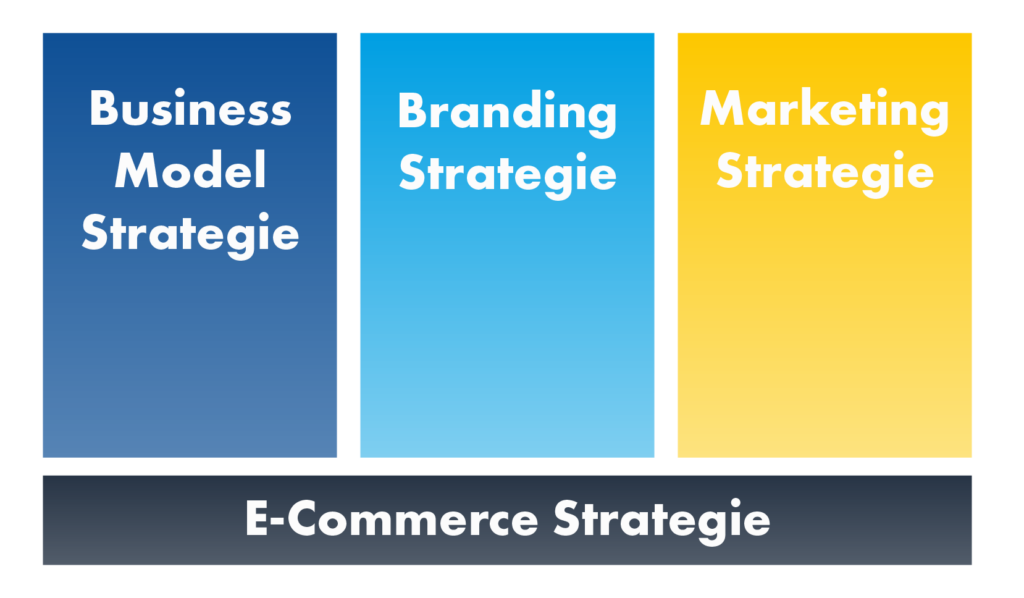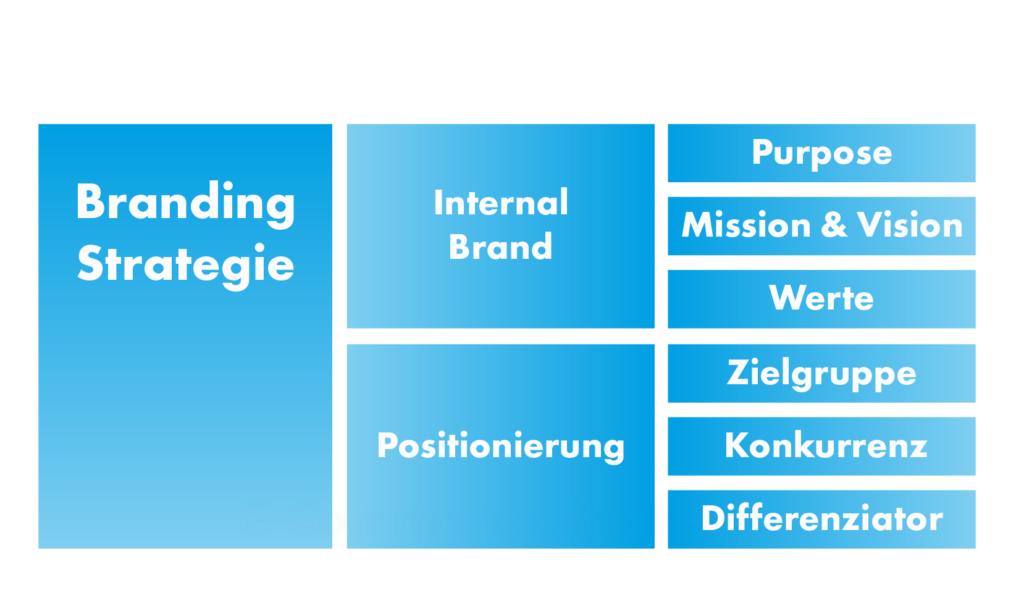E-commerce strategies, part 2: Brand strategy
Share this article
Tags
Categories

In the second part of our mini-series on e-commerce strategies, we look at a company's brand strategy. As you can see in the previous article on Business model a successful and comprehensive e-commerce strategy consists of three parts:

This article deals with branding, or in other words: the development of a brand strategy. What exactly is branding? Why is it essential for the success of a company, now more than ever, and what elements are involved?
What exactly is a brand, what is a brand?
E-commerce companies are more than just a website - they are a brand. And to build a successful business, you need a strong brand that is consistent, relevant and emotionally appealing to your customers.
Your brand is the image that customers, prospects and partners have of your company. Your brand is the company's promise to your customers. It tells them what they can expect from your products and services, and it differentiates your offering from that of your competitors. You can have the best product, the most useful services at the best price, but if your branding doesn't resonate with your target audience and inspire trust, your chances of success are slim.
Your brand is the result of three factors: who you are, who you want to be and how you are perceived by others.
"Your brand is what people say about you when you're not in the room."
Jeff Bezos
A brand is therefore not just a logo or a slogan - it is rather the sum of all points of contact that customers have with your company. Your visual identity (i.e. logo, colors, visual appearance) plays an important role in conveying who you are as a company. But it is by no means the only element that contributes to a positive customer experience.
The result of your branding is a series of marketing and communication methods that help to differentiate your company and its products from the competition and leave a lasting impression in the minds of your customers.
The elements of a brand strategy
The elements of a brand strategy can be divided into "internal brand" and positioning strategy.
With your internal brand, you develop and define what your company is all about at its core. It is important to think beyond the economic goals: what drives you, your company and the people who are part of it?
A positioning strategy is the process of choosing the specific direction you want your brand to take - in other words, who you want to market your company's products to and how you want to differentiate yourself from the competition.

The Internal Brand
The internal brand is the DNA of your company. Your brand needs a solid idea of where it is going, why it is doing this, how it will get there and what impact it wants to have on customers, the environment and employees.
The three building blocks of an Internal Brand are:
- The purpose, the meaning and purpose of a brand
- The mission and vision of a company
- The values that guide your company's decisions and actions
Purpose, mission and vision form the "Golden Circle" defined by Simon Sinek, author of the book "Start with Why". Sinek first introduced this idea in 2009 in a highly acclaimed TED talk entitled "How great leaders inspire action" to a worldwide audience.
"People don't buy what you do; they buy why you do it. The goal is not to do business with everybody who needs what you have. The goal is to do business with people who believe what you believe."
Simon Sinek
The purpose, the core of a brand
The purpose is the "why" of a company - its raison d'être, what it stands for and why it exists. You can define this why in political, ethical, moral or results-oriented terms.
The purpose of a brand gives it relevance and makes it necessary for its customers. It influences every business decision and creates loyalty, affinity and connections with customers. A brand must solve a problem or satisfy a need; how well it does this distinguishes the winners from the losers.
"The brands that will thrive in the coming years are the ones that have a purpose beyond profit."
Richard Branson
This purpose can reflect the founders' lives and experiences, their perception of a gap in the market or the need for change and innovation in a particular market sector.
Brands with a strong (or strongly communicated) purpose include Nike, Dove and The Body Shop.
Mission & Vision
The mission and vision are the "what" and the "how" of a company. Your vision describes what goals you are pursuing and what the purpose of your brand is. It sets the guidelines for what your company will look like and how your consumers will perceive your brand in the future. It should be ambitious and aspirational as well as inspiring.
A few guiding questions can help you formulate your own authentic vision:
- Why are your products or services important?
- What makes your company unique?
- How will your future customers describe your brand?
One example of a far-sighted vision is that of Tesla:
To create the most compelling car company of the 21st century by driving the world's transition to electric vehicles.
Tesla
The mission, in turn, is derived from a company's vision. It shows what the company is committed to today in order to achieve its visionary goals in the future.
Without a mission, the vision is just a dream. Without a vision, the mission is aimless.
A mission must define clear steps and procedures; it is specific and consistent. It obliges every part of a company to adhere to these goals and act accordingly.
Values
Whether in brand management or in your private life: Your behavior is determined and shaped by the values you represent. What does your company believe in at its core? How does it act accordingly? How do these values affect your company's behavior?
It is important to clearly define values for your company. These values form the basis for everything you do as an actor in your company. They should be reflected in your products and services, in the way you treat your customers, in the behavior of your employees and in decisions about new products or services - and even in physical spaces such as retail stores or office buildings.
Consistently adhering to these values helps people to develop trust and thus affection for your brand. Your value-based behavior ultimately influences both purchasing decisions and the loyalty of your customers.
The positioning of your company
The positioning of your brand is not something that is entirely in your hands, something that you can plan ahead and control precisely on paper. Your customers also unconsciously position your brand based on their experiences with your brand. Your visual identity, your messages, your story and your personality (i.e. the previously defined DNA) all play a role here. Influencing how your target group positions your brand is a cornerstone of any successful brand strategy.
A well-thought-out positioning strategy that consolidates your brand as well as possible in the minds of your customers is defined by three cornerstones:
- Target group
- Competition
- Differentiation strategy
Target group
It is essential for every company to know its customers - those who are most likely to buy its product or service.
Creating a "user persona", even in B2B, is only the first step here. Firmographic criteria do not paint the full picture. In order to really respond to your customers' needs at every step of the user journey, it is important to know their emotional states:
- What are their goals?
- What do they really need?
- What problems do they repeatedly encounter with your competitors when they want to solve these problems?
- How does this in turn influence their emotions?
Branding is about resonance. And there's no better way to achieve this than to demonstrate a deep understanding of your customers' problems and how these problems affect their lives.
Competition
It's important to understand the competitive landscape before you decide on a positioning. Start by identifying your competition and study them, their products and their marketing efforts. Ask yourself:
- How do your products differ from mine?
- What are their strengths and weaknesses?
- How does your communication strategy work?
- What are my competitors telling the world about their products through advertising, packaging and social media?
- How do I compare to my competitors in terms of quality, price or brand awareness?
- Are there any gaps in the market that I could fill with my product range?
Differentiator
Your differentiation strategy defines how your products differ from those of your competitors. It is primarily about determining the unique selling point that makes you unique and special for your customers.
There are various approaches to a differentiation strategy. The most common are the following:
- Price leadership
There are two options for positioning yourself: either as a low-price leader that offers your customers excellent value, or as a premium brand with a high price. - Brand presentation
How a brand presents itself in the marketplace can be a differentiator. In this case, brands that use a consistent character or mascot can easily be remembered and stand out from the competition. - Innovation
This can be expressed through the physical characteristics of the products or the way in which products or services are provided. This differentiation solves an unmet need in a unique and novel way. - Emotional connection
It is based on the emotional appeal that people associate with a product or service. Experience shows that brands that build an emotional connection with their customers are often even better positioned than brands that offer greater value.
Conclusion: Brand strategy is a cornerstone for long-term success in e-commerce
Take the time to study your competition. Find out who your target customers are and what drives them - what needs they have, what problems they face. And then create a brand identity that fits well with this group of people. This way, they will build trust in your company and will be happy to come back to you again and again.
However, a successful brand strategy also needs staying power: it works best when it is applied consistently and over a long period of time, rather than haphazardly.
In part 3 of this series, you will learn more about the Marketing strategy.
Further contributions
No contributions found.
